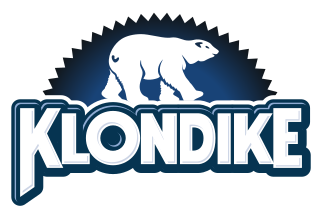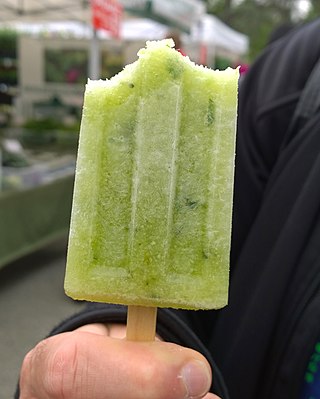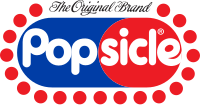
A Klondike bar is a Good Humor-Breyers ice cream novelty consisting of a square of ice cream coated with a thin layer of chocolate.

A choc ice or ice cream bar is a frozen dessert generally consisting of a rectangular block of ice cream—typically vanilla flavour—which is thinly coated with chocolate. Related products may also include other fillings with the ice cream and be styled similar to candy bars. The term has also been used as a racial slur.

A freezie or a freeze pop is a water-based frozen confection similar to an ice pop. It is made by freezing flavored liquid such as sugar water, fruit juice or purée inside a plastic casing or tube, either round or flat. Freezies come in sealed plastic tubular wrappers and conform to the shape of the wrapper when frozen to serve; as such, they do not need to be stored cold. They also do not need to be frozen as solidly as an ice pop and can have a consistency similar to that of a slushie. Freezies are sold in a variety of flavors, including cherry, orange, lemon-lime, watermelon, cream soda, blue raspberry and grape.

Good Humor is a Good Humor-Breyers brand of ice cream started by Harry Burt in Youngstown, Ohio, US, in the early 1920s with the Good Humor bar, a chocolate-coated ice cream bar on a stick sold from ice cream trucks and retail outlets. It was a fixture in American popular culture in the 1950s when the company operated up to 2,000 "sales cars".

Breyers is a brand of ice cream started in 1866 by William A. Breyer in Philadelphia, Pennsylvania.

Good Humor-Breyers is the American ice cream division of Unilever and includes the formerly independent Good Humor, Breyers, Klondike, Popsicle, Dickie Dee and Sealtest brands. Based in Englewood Cliffs, New Jersey it was formed in 1993 after Unilever purchased the ice cream division of Kraft General Foods.

Fla-Vor-Ice is the trademark name for a type of freezie. Unlike traditional popsicles, which include a wooden stick, Fla-Vor-Ice is sold in and eaten out of a plastic tube. Also unlike traditional popsicles, it is often sold in liquid form and requires the consumer to freeze the product at home. A vendor, though, may sell them frozen.

An ice pop is a liquid/cream-based frozen dessert on a stick. Unlike ice cream or sorbet, which are whipped while freezing to prevent ice crystal formation, an ice pop is frozen while at rest, becoming a solid block of ice. The stick is used as a handle to hold it. Without a stick, the frozen product would be a freezie.

Dickie Dee is a Canadian brand of ice cream currently owned by Good Humor-Breyers.
Harry B. Burt was an American confectioner who developed the ice-cream novelty known as the Good Humor bar. Burt is widely credited with revolutionalizing manufacturing, marketing, and distribution techniques for ice-cream products.

Choco Taco was a Good Humor-Breyers ice cream novelty resembling a taco. It consisted of a disk of waffle cone material folded to resemble a hard taco shell, reduced-fat vanilla ice cream, artificially flavored fudge, peanuts, and a milk chocolate coating. The Choco Taco was marketed under the Klondike brand as "The Original Ice Cream Taco".
Mövenpick Ice Cream is a brand of ice cream of Swiss origin produced initially by Nestlé. Since 2016, Froneri - a joint venture between Nestlé and R&R Ice Cream - manufactures it.
Paddle Pop is a brand of ice confection products originally created by Streets, which is now owned by the English-Dutch company Unilever. It is sold in Australia, New Zealand, and a few other countries. It is held for eating by a wooden stick which protrudes at the base. The brand has a mascot known as the Paddle Pop Lion, or Max, who appears on the product wrapper.

A screwball is a type of frozen confection that first appeared in the 1970s. It consists of ice cream inside a conical, plastic cup with a gumball at the bottom. The name was originally a commercial product name but is now used to describe all such ice cream treats.

Halo Top Creamery is an ice cream company and brand sold in the United States, Australia, Mexico, Canada, Ireland, New Zealand, the Netherlands, Germany, Denmark, Taiwan, Hong Kong, South Korea, Austria, United Kingdom and the United Arab Emirates. The brand is marketed as a lower-calorie alternative, partially substituting sugar with stevia, a plant-based sweetener, and erythritol, a sugar alcohol.

Kulfi is a restaurant with two locations in Portland, Oregon.














